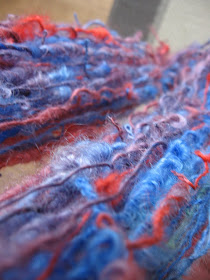Yesterday was a very strange day. 10 inches of snow may not seem like much, but it's enough to knock out the power and worse, even when the electricity comes back on, the cable, phone and internet remain offline most of the day. Yesterday I was snowed in with almost no contact with the outside world. It is a weird feeling.
But, not all was lost. I got to shovel the driveway, see to the animals here on the farm, and play with yarn.
I've been spinning yarn to sell at
Knotty by Nature. It is very nice of them to sell my yarn. I cannot make huge amounts like a commercial mill, but I do think I make quality. I aim to make something that a large company could not make, and maybe that's why it takes so much more time to create that special yarn.
I've been playing with different ways of pricing the handspun yarn. I think I've found a way of pricing that I'm happy with. It's determined per yard and per times it goes through the wheel. So a plied yarn will be more than a single, and the like. It's works out to be less expensive than people sell on
Etsy.com, but more than commercial yarn. Still, I'm only getting about $2 per hour of work I put into the yarn, but when I priced it so that I get around $5 per hour, it didn't sell.
Even still, I hear complaints that it's too expensive, it's not the exact colour they want, I'm not fast enough at spinning, stuff like that. (so far no complaints about quality which makes me happy - mostly just complaints about there not being enough which I suppose should make me happy)
I am not a huge spinning mill. I can only make it the colour of the fibre I have available to me- I use dyes very seldom and when I do, it basically doubles the price because of the kinds of dyestuff I use and my lack of facilities. Quality handmade goods, yarn included, take time and skill. Because of that handspun yarn comes in smaller batches and cannot always be made to order and ready the next day.
But, no matter... I complain too much.
There is compensation for my rantings. Yarn photos:
These two photos taken prior to blocking
So pretty! I love how this Single Boucle turned out. I feel that I am really getting the hang of this technique. This last batch turned out much better and stronger than the yarn I spun before Christmas. This is spun from English Leicester. I buy the locks already dyed, and thus the yarn has a random colour sequence and effect.
There is more of this Singles Boucle at the shop already, I just forgot to take photos of it before I sent it off.
Someone had recently given my some samples of Alpaca. So I hand carded them into little rolags and spun a random colour sequence of natural colours.

Aren't alpacas amazing to have such a variety of colour? I love it!
My aim with this yarn was to give it a homespun effect. I left in small slubs and encouraged slight variation of texture throughout the yarn. The different lengths of the fibre that I was given helped to achieve this effect. It also fluffed up quite nicely when it washed, so I imagine it will provide a nice halo to the finished fabric.
Each colour lasts for about 2-4 yards and the total length of this yarn is over 300 yards. As I spun it I imagined it being knit into a lace scarf, but it would look good as anything.
This is not a yarn I can produce any more of as I only had a handful of fibre. It's limited edition. However, my new alpacas are very similar colours, so if someone likes this yarn, I should be able to make something like it when they are shorn in late spring.
And then there is the grey Romney.
I had intended to spin this with a lovely homespun texture like the alpaca, but I stopped paying attention early and it ended up as a rather constant yarn.
There are over 400 yards of this heathered yarn. It has a wonderful hand. It would be lovely as lace, mitts (maybe with some brightly coloured yarn?), or maybe someone could dye it for that lovely depth of colour that grey fibre adds to any dyeing.
To be honest, I'm not altogether certain I want to sell this yarn. It would be strong enough for warp or weft and given the amount of weaving I've been doing lately, I could see using it for my own project.
I'm actually rather attached to all three of these yarns. But, I could do with the money. I hear a rumour that there might be a half day Saori workshop twice a month. Now, it's just a rumour, but it sure would be nice to have some money just in case it turns out to be true.









































